细胞信号转导1
细胞信号转导(1)

Degredation of cAMP
激素
结合
G蛋白偶联受体
G蛋白
ATP
腺苷酸环化酶
Mg2+ ,or Mn2+
cAMP
蛋白激酶A (Protein kinase A,PKA)
级联反应(靶酶磷酸化、直接激活特定的转录调控因子 )
PKA的作用机制: 使底物蛋白磷酸化
TGACGTCA
底物:
cAMP反应原件结合蛋白(CREB)
第一信使:由细胞分泌的能够调节机体功能的一 大类生物活性分子。 根据胞外信号的特点及作用机制分: 激素--胰岛素、甲状腺素、肾上腺素
神经递质:乙酰胆碱、去甲肾上腺素
局部化学介质:生长因子、前列腺素、NO
激素 神经递质 局部介质
激动剂: 与受体结合后产生效应
Ⅰ型激动剂
Ⅱ型激动剂
拮抗剂:与受体结合后不产生效应,但可阻断激动
入血
葡萄糖
6-磷酸葡萄糖
1-磷酸葡萄糖
肾上腺素
3.糖原分解的停止
肝细胞膜表面受体
G蛋白
腺苷酸环化酶(AC)
磷酸二酯酶
ATP 无活性PKA
无活性的 磷酸化酶激酶
cAMP
5’ AMP
活化的PKA
磷酸酶
活化的 磷酸化酶激酶
磷酸酶
糖原磷酸化酶b
糖原磷酸化酶a 1-磷酸葡萄糖 糖原
入血
葡萄糖
6-磷酸葡萄糖
PLC
信号刺激
细胞内钙库 质膜
钙通道开放
胞内钙离子浓度瞬时升高 形成钙离子-CaM复合物 激活靶酶
蛋白质磷酸化酶激酶(PhK) 肌球蛋白轻链激酶(MLCK) 钙调蛋白依赖性蛋白激酶(CaM-PK)
细胞的信号转导医学细胞生物学

细胞信号转导的分类
01
根据信号分子种类的不同,细胞信号 转导可以分为亲脂性信号转导和亲水 性信号转导。
02
亲脂性信号转导主要涉及类固醇激素 、甲状腺激素等脂溶性激素,而亲水 性信号转导则涉及氨基酸、肽类、核 苷酸等水溶性分子。
03
此外,根据信号转导途径的不同,细 胞信号转导还可以分为受体介导的信 号转导和非受体介导的信号转导。受 体介导的信号转导主要涉及配体-受 体相互作用,进而激活一系列的信号 分子和酶促反应;而非受体介导的信 号转导则主要涉及细胞内某些化学反 应或物理刺激引起的信号转导。
指导。
新药靶的抗肿瘤作用研究
要点一
总结词
新药靶的抗肿瘤作用研究是信号转导领域的重要应用方向 ,旨在开发针对肿瘤细胞特异信号通路的创新药物。
要点二
详细描述
肿瘤的发生发展与细胞信号转导通路的异常密切相关。针 对新发现的靶点,研究者们会评估其在抗肿瘤中的作用, 包括抑制肿瘤细胞增殖、诱导细胞凋亡、抑制肿瘤血管生 成等方面。通过体外实验和临床试验,验证新药靶在抗肿 瘤治疗中的潜在应用价值,为肿瘤治疗提供新的策略和药 物候选物。
02 医学细胞生物学基础
医学细胞生物学定义
医学细胞生物学是一门研究细胞的结 构、功能、生长、发育、代谢、遗传 和疾病等生命现象的科学。它以细胞 为基本单位,研究细胞的组成、结构、 功能和相互关系,以及细胞在生命活 动中的作用和变化规律。
VS
医学细胞生物学是医学领域中一门重 要的基础学科,它为医学研究和临床 实践提供了重要的理论基础和技术支 持。
信号转导与疾病的诊断
分子标志物
信号转导相关分子可作为疾病诊断的标志物。例如,某些癌症患者体内存在异常激活的信号转导分子,这些分子可作 为癌症诊断的指标。
植物生理学—信号转导1

植物细胞信号转导
植物细胞信号转导的概念、特点 研究内容和意义
植物细胞信号转导过程
刺激与感受 信号转导 蛋白质可逆磷酸化 细胞反应
§1 植物细胞信号转导概述 • 植物生命活动
– 物质代谢 – 能量转化 – 信息流 物质流 信息流 能量流
• 一种特殊的代谢过程 • 传递环境变化的信息 • 调节和控制物质与能量代谢\生理反应\生长发育 物质流、能量流一起组成植物体的生命活动全过程
生效应。自然条件下发生涝害或淹水时植株体内就经常存在
这类信号的传递。
胞间信号的传递
2.化学信号的韧皮部传递 韧皮部是同化物长距离运输的主要途径,也是化学信号 长距离传递的主要途径。植物体内许多化学信号物质,如ABA、 JA-Me、寡聚半乳糖、水杨酸等都可通过韧皮部途径传递。 一般韧皮部信号传递的速度在0.1~1mm·s-1之间,最高可达 4mm·s-1。 3.化学信号的木质部传递 化学信号通过集流的方式在木质部内传递。 近年来这 方面研究较多的是植物在受到土壤干旱胁迫时,根系可迅速 合成并输出某些信号物质,如ABA。根系合成ABA的量与其受 的胁迫程度密切相关。合成的ABA可通过木质部蒸腾流进入叶 片,并影响叶片中的ABA浓度,从而抑制叶片的生长和气孔的 开放。
异三聚体G蛋白
小G蛋白
1. 2. 3. 4.
静息态; 胞间信号与受体结合; G蛋白与受体结合被激活,甩去GDP,暴露GTP结合位点; G蛋白与GTP结合,蛋白质构象改变,脱去效应器活性 位点抑制因子β亚基; 5. 激活的G蛋白水解GTP,触发效应器,把胞间信号转换位 胞内信号; 6. G蛋白重新结合β亚基回到原初构象,恢复静息态。
膜表面受体主要有三类
• 目前研究接受外界信号必需的植物受体主要有 三种: 植物激素受体 光信号受体(包括对红光和远红光敏感的 光敏色素、对蓝光敏感的蓝光受体和对紫外敏 感的紫外光受体) 感病诱导因子受体。 现在对光敏色素的研究比较深入,对植物激素受体的
细胞的信号转导

• 由膜上的腺苷酸环化酶(AC)环化胞浆内 • ATP形成cAMP。 • cAMP是最早确定的第二信使。 正常情况下,cAMP的生成与分解保持平衡,使 胞浆内cAMP浓度保持在10-7M以下。当配体与受体 结合后,1个AC可生成许多cAMP,使cAMP的水平 在几秒钟内增高20倍以上。
• • • • • • •
3. PLA 2 –AA信号转导系统 花生四烯酸( AA)是通过磷脂酶水解膜磷脂释放的不饱
和脂肪酸。 1)PLA2的激活机制 :
许多细胞外信号(如肾上腺素能激动剂、缓激肽、凝血
酶等)都可激活PLA2,有些PLA2通过G蛋白激活;有些 PLA2被PLC激活,PLC通过增加胞内Ca2+、或激活PKC间 接激活PLA2。细胞外信号刺激PLA2途径直接在sn-2位置 脱酯释放AA,是生成AA的重要途径,也是细胞调控AA生
期使用激动剂和拮抗剂的药理或病理情况下,将之除去后受体 数量和反应性均可恢复。
(2)根据调节的种类,分为
1)受体的数目与结合容量:促使受体数目或结合
容量增加的调节称为上调。反之称为下调。
2)反应性:在内环境影响下,受体反应性会产生增
敏、失敏等现象。 增敏:细胞在某种因素的作用下,受体与配体结合的
敏感性增加。如甲状腺素可增加细胞对儿茶酚胺、TSH、
第二节 细胞的跨膜信号转导功能
• 跨膜信号转导 • (transmembrane signal transduction)
(一)细胞信号转导
1. 细胞信号转导的概念
不同形式的外界信号作用于细胞时,通常并不进入细胞或 直接影响细胞内过程,而是作用于细胞膜表面(少数类固 醇激素和甲状腺激素除外)通过引起膜结构中一种或数种 特殊蛋白质分子的变构作用,将外界环境变化的信息以新
细胞信号转导与作用细胞生物学论文(1)
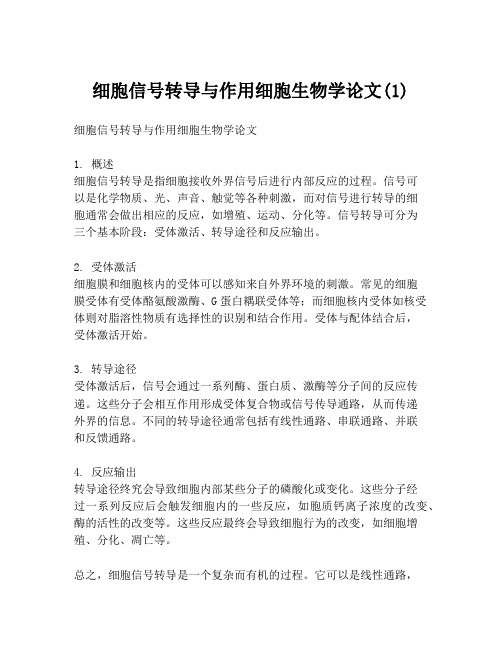
细胞信号转导与作用细胞生物学论文(1)
细胞信号转导与作用细胞生物学论文
1. 概述
细胞信号转导是指细胞接收外界信号后进行内部反应的过程。
信号可
以是化学物质、光、声音、触觉等各种刺激,而对信号进行转导的细
胞通常会做出相应的反应,如增殖、运动、分化等。
信号转导可分为
三个基本阶段:受体激活、转导途径和反应输出。
2. 受体激活
细胞膜和细胞核内的受体可以感知来自外界环境的刺激。
常见的细胞
膜受体有受体酪氨酸激酶、G蛋白耦联受体等;而细胞核内受体如核受体则对脂溶性物质有选择性的识别和结合作用。
受体与配体结合后,
受体激活开始。
3. 转导途径
受体激活后,信号会通过一系列酶、蛋白质、激酶等分子间的反应传递。
这些分子会相互作用形成受体复合物或信号传导通路,从而传递
外界的信息。
不同的转导途径通常包括有线性通路、串联通路、并联
和反馈通路。
4. 反应输出
转导途径终究会导致细胞内部某些分子的磷酸化或变化。
这些分子经
过一系列反应后会触发细胞内的一些反应,如胞质钙离子浓度的改变、酶的活性的改变等。
这些反应最终会导致细胞行为的改变,如细胞增殖、分化、凋亡等。
总之,细胞信号转导是一个复杂而有机的过程。
它可以是线性通路,
也可以是多重通路,甚至是网络通路。
它可以通过很多途径达到不同的细胞反应,从而影响细胞的生理行为。
理解信号转导和掌握其应用非常重要,可以应用于疾病治疗和药物开发等领域。
细胞的信号转导

一、细胞信号转导概述(一)信号转导的概念在多细胞生物体中,细胞间的信号转导(signaltransduction)与交换对细胞的生存非常重要。
细胞的信号转导是通过多种分子相互作用的一系列有序反应,将来自细胞外的信息传递到细胞内各种效应分子,并产生生物效应的过程。
通常所指的信号转导是指跨膜信号转导(transmembrane signal transduction),即生物活性物质(如神经递质、激素、细胞因子等)通过受体或离子通道的作用,将其转变为细胞内各种分子数量、分布或活性的变化,从而对细胞的功能、代谢、生长速度、迁移等生物学行为产生影响。
(二)信号转导系统的基本组成细胞信号转导系统通常由信息分子(signaling molecule)、受体(receptor)、转导体(transducer)及效应体(effector)四个环节组成。
信息分子的受体位于靶细胞的质膜上、胞质或核内,与之相结合的相应信息分子统称为配体(ligand)。
配体与受体的结合可诱导受体的构象发生变化,激活转运体,进而启动细胞内的信息转导途径(如效应体的级联反应),最终导致细胞功能的改变。
(三)信号转导的主要途径根据介导的配体和受体的不同,信号转导可分为两大类,一类是水溶性配体或物理信号作用于膜受体,随后经历跨膜和细胞内信号转导体的依次作用,最终作用于效应体,产生效应。
依据膜受体特性的不同,这类信号转导又有多种通路,主要是由离子通道型受体、G蛋白耦联受体、酶联受体和招募型受体介导的信号转导。
另一类是脂溶性配体直接与胞质受体或核受体结合而发挥作用,这类方式通常都是通过影响基因表达而产生效应。
应当注意到膜受体介导的信号转导也大多可以影响转录因子的活性而改变基因的表达。
(四)信号转导途径间的交互联系细胞信号转导通路的细节非常复杂,涉及蛋白质等相互作用以及相关基因表达的过程,而且各种信号转导通路间存在更为复杂的联系,构成错综复杂的信号网络(signaling network)。
细胞的信号转导

4. 自分泌信号:与上述三类不同的是,信号发放细胞和靶
细胞为同类或同一细胞,常见于癌变细胞。
从溶解性来看又可分为脂溶性和水溶性两类:
脂溶性信号分子:如甾类激素和甲状腺素,可直接穿膜进入靶细胞 ,与胞内受体结合形成激素-受体复合物,调节基因表达。
其共同特点是: ①特异性 ②复杂性 ③时间效应
按产生和作用方式分:
1. 激素 :内分泌信号,经血液或淋巴循环转运,作用距离
远、范围大、持续时间长。如:胰岛素、甲状腺素、肾 上腺素等
2. 神经递质:突触分泌信号,作用时间、距离短,如: 乙
酰胆碱、去甲肾上腺素等
3. 局部化学介质 :旁分泌信号,通过细胞外液介导,作用
参与G蛋白偶联受体进行信号转导的第二信使有cAMP 、cGMP、三磷酸肌醇(IP3)和二酰基甘油(DAG )、Ca2+等。第二信使的作用是对胞外信号起转换和 放大的作用。
(一)cAMP信号途径
1、刺激性/抑制性激素和相应受体
Gs/ Gi
腺苷酸环化酶(AC):跨膜12次,在G蛋白激 活下,催化ATP生成cAMP。
Adenylate cyclase
2、依赖cAMP的蛋白激酶A(Protein Kinase A, PKA):由两个催化亚基和两个调节亚基组成。
•cAMP与调节亚基结合,使调节亚基和催化亚基解离, 释放出催化亚基,激活蛋白激酶A的活性。
3、环核苷酸磷酸二酯酶(PDE):降解cAMP生成5’-AMP ,终止其信号功能。
量氯离子和水分子持续转运入肠腔 ,引起严重
腹泻和脱水。
四、蛋白激酶功能异常
肿瘤促进剂佛波酯与DAG结构类似,取代其与 PKC结合而活化PKC,但不被降解,从而使PKC 不可逆活化,细胞不可控的生长、增殖。
细胞信号转导的机制与重要性

细胞信号转导的机制与重要性细胞信号转导是细胞间相互沟通、协调生命过程的重要方式。
正常的细胞信号转导对于生命体的生长、分化、代谢、免疫等功能的正常发挥至关重要。
本文将探讨细胞信号转导的机制及其在生物学中的重要性。
一、细胞信号转导的基本机制1. 信号传导的起始步骤细胞信号转导的起始步骤是外部刺激物与细胞膜上的受体结合,形成受体激活。
这些受体可以是蛋白质、离子通道、酶等多种类型。
一旦受体激活,会触发一系列的细胞内信号传导。
2. 转导信号的传递细胞内信号传导的过程主要通过信号分子在细胞内的转导传递完成。
这些信号分子包括离子、细胞内信号蛋白、细胞因子等。
它们通过不同的路径,如细胞内信号通路、离子通道等,将信号传递到下游分子,最终调控细胞内的生物过程。
3. 下游效应的调节细胞内信号传导最终会调节下游的效应,包括基因的表达、蛋白质的合成等。
这些效应的实现可以通过激活或抑制特定的转录因子、启动或关闭特定基因的转录以及调节细胞内蛋白质的活性等方式完成。
二、重要性与生物学意义1. 细胞发育与分化细胞信号转导在胚胎的发育和分化中起着重要作用。
例如,在胚胎发育过程中,细胞间的信号转导可以引导细胞的定向移动、增殖和分化,最终形成不同的器官和组织。
2. 维持基本生物过程细胞信号转导对于细胞内基本的生物过程的调控至关重要。
例如,细胞信号转导可以调节细胞的新陈代谢过程,维持细胞内的能量平衡。
此外,细胞信号转导还能调控细胞的增殖和凋亡,维持组织和器官的稳态。
3. 免疫和炎症反应细胞信号转导在免疫和炎症反应中起着关键作用。
免疫细胞通过识别外来抗原并通过信号转导路径激活免疫应答,从而引发身体的免疫反应。
炎症反应中,信号转导可以调节炎症介质的合成和释放,参与组织的修复和免疫细胞的趋化。
4. 神经传导细胞信号转导在神经系统中的重要性不可忽视。
神经元通过神经递质信号的传导,实现神经系统中信息的处理和传递。
神经递质信号转导的研究不仅对于理解神经系统功能有重要意义,还对神经系统疾病的治疗提供了重要线索。
细胞信号转导和细胞通信

细胞信号转导和细胞通信细胞是生命的基本单位,不同细胞在生物体内密切合作,完成各种生理功能。
为了实现这种协作,细胞之间需要进行精密的信号转导和通信。
细胞信号转导是一种复杂的过程,其中包括多种信号分子、受体和信号通路的参与。
本文将介绍细胞信号转导的基本概念、信号分子的类型以及细胞通信的机制。
一、细胞信号转导的基本概念细胞信号转导是指外界刺激通过信号分子传递到细胞内部,并引起相应的生物学响应的过程。
这个过程涉及多个组分,包括信号分子、受体和信号通路。
信号分子可以是离子、小分子物质或蛋白质,它们在细胞外和细胞内之间传递信息。
受体则是细胞膜上的蛋白质,可以与信号分子结合并传递信号。
信号通路是指信号分子与受体结合后所经过的一系列化学反应和调控,最终实现细胞内的生物学效应。
二、信号分子的类型信号分子可以分为多种类型,包括激素、神经递质、生长因子等。
激素是一类由内分泌腺分泌的物质,它们通过血液循环传播到身体各个部位,并影响细胞的行为。
神经递质是神经细胞释放的化学物质,在神经元之间传递电信号,并触发细胞内的相应反应。
生长因子则促进细胞的增殖和分化,在胚胎发育、伤口修复等过程中起着重要作用。
三、细胞通信的机制细胞通信是细胞之间相互协作的重要方式,可以通过直接接触或信号分子传递实现。
细胞间的直接接触包括细胞间连接和细胞间黏附。
细胞间连接是通过细胞膜蛋白的结合实现的,可以传递电信号和分子信号。
细胞间黏附是指细胞表面的特定蛋白质相互结合,形成稳定的细胞群体,并进行相互作用和通信。
此外,细胞之间还可以通过信号分子传递来进行通信。
信号分子可以在细胞间的空间中自由扩散,通过结合受体来传递信息。
这种信号传递方式可以实现长距离的通信,并对细胞产生广泛的影响。
四、细胞信号转导的调控细胞信号转导是一个高度调控的过程。
细胞通过多种机制来调节信号转导的强度和时机。
其中包括信号通路的激活和抑制,信号分子的合成和降解以及受体的调节等。
细胞信号转导的调控机制能够确保细胞对外界刺激做出适当的生物学响应,并避免过度反应或错误反应的发生。
细胞信号传导

6类酶联受体
第三章 酶偶第联一受章体介导的信论号文传导导读
• 酶联受体是第二大类的细胞表面受体,最初是通过它们对胞外信号蛋白的应答中的作用被 发现的。这些信号蛋白促进动物组织中细胞的生长、增殖、分化或存活,被称为生长因子。
• 与G蛋白偶联受体一样,酶联受体也是跨膜蛋白。配体结合结构域位于质膜的外面,它要么 具有内在的酶活性要么直接与某种酶结合。目前为止发现6类酶联受体:
2.6 cAMP浓度升高激活基因转录
① 胞外信号分子与G蛋白偶 联受体结合,使得腺苷酸环 化酶激活,促进ATP合成 cAMP
② cAMP浓度增加激活胞质 内的PKA,释放的催化亚基 通过核孔进入细胞核
③ 激活的催化亚基结合无活 性的CREB基因调控蛋白使其 磷酸化从而被激活
④ 激活的CREB招募辅激活蛋 白CBP,CBP激活基因转录
调节域
C1:富含Cys,DAG和TPA 结合部位 C2:+结合部位
催化域
C3:ATP结合部位 C4:结合底物并进行磷酸化转移
在无活性状态,PKA是 由两个催化亚基和两个 调控亚基组成的复合体。
cAMP与调控亚基 结合后改变调控亚 基的构象,导致调 控亚基从复合体中 解离
释放的催化亚基被 活化从而磷酸化特 定的底物蛋白分子
第一章 细胞信号传导原理
1.4 胞内信号传递的形式
信号分子结合在信号 细胞的表面,只影响 与之接触的细胞
信号传递由神经元执 行,神经元沿着轴突 传递电信号,并在突 触处释放神经递质
第一章 细胞信号传导原理
信号分子被释放到细 胞外间隙,局部作用 于相邻细胞
内分泌细胞分泌激素 到血流中,随着血流 广泛分布于身体的各 个部位
受体酪氨酸激酶磷酸化一小类胞内信号 蛋白上的特定酪氨酸
细胞信号转导的意义及其应用

细胞信号转导的意义及其应用细胞信号转导(cellular signaling pathway)是细胞内外发生的能够调控细胞行为的过程。
它涉及到复杂的分子互作、反应途径和调节机制,其中包括了分子信号的接收、传递和响应。
这个过程在细胞内外的正常空间环境下,或者根据特定的利益集合,在异常环境中发挥着先导作用。
因此,细胞信号转导的研究成为了许多学科的重要研究方向。
本文主要介绍细胞信号转导的意义、应用及其相关研究进展。
一、细胞信号转导的意义细胞信号传导通常指细胞之间的通讯和信息交流过程。
它是维持细胞的功能和生存所必需的基础。
细胞信号传导被广泛认为是细胞生物学中最重要的研究领域之一,其研究对生命科学的发展和应用有很大的贡献。
1. 主要控制生物过程生物体是由不同种类的细胞组成的,每种细胞都具有自己的特定功能和生存条件。
细胞信号转导是生物复杂多样的细胞之间进行通讯和交流的核心机制。
它通过调节响应细胞内、外环境变化的反应,使细胞在不同的状态下保持自身特定的行为。
细胞间的信息传递和互相作用,控制了许多重要的生命过程,如细胞增殖、分化,以及癌症、心血管等疾病的发生等。
2. 可以启发新的治疗策略由于细胞信号转导是控制生物过程的关键因素之一,因此研究它已成为许多领域的重要课题。
正常情况下,它是为了维持生物体的正常生理功能而存在。
但当信号转导通路异常时,它可能会导致各种疾病的发展。
研究细胞信号转导可以识别与疾病相关的信号,为疾病的治疗提供新的思路和方法。
对于癌症来说,深入研究信号转导通路的分子机制,找到抑制癌细胞的关键信号分子,可以为靶向癌症治疗提供新途径。
二、细胞信号转导的应用随着细胞信号转导的研究深入,人们已经可以将相关知识用于医学诊断、预防、治疗和药物开发等方面。
以下是细胞信号转导的主要应用。
1. 新药研发药物研发是细胞信号转导的一个重要应用领域。
利用细胞信号通路的相关机制和调节途径,可以构建更加精准的药物靶点,提高药物疗效。
细胞信号转导的四种途径
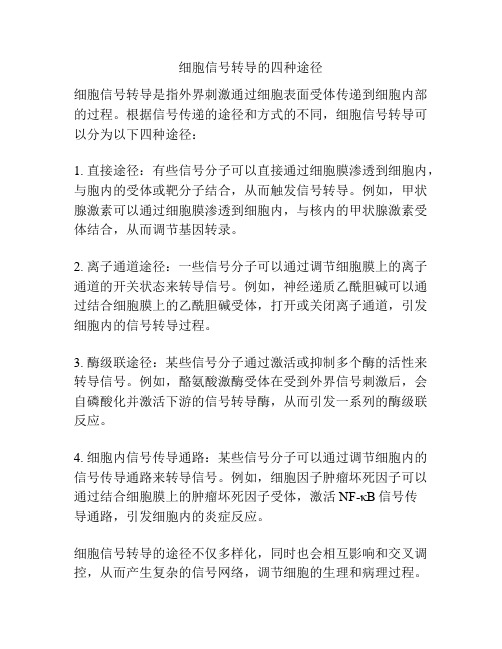
细胞信号转导的四种途径
细胞信号转导是指外界刺激通过细胞表面受体传递到细胞内部的过程。
根据信号传递的途径和方式的不同,细胞信号转导可以分为以下四种途径:
1. 直接途径:有些信号分子可以直接通过细胞膜渗透到细胞内,与胞内的受体或靶分子结合,从而触发信号转导。
例如,甲状腺激素可以通过细胞膜渗透到细胞内,与核内的甲状腺激素受体结合,从而调节基因转录。
2. 离子通道途径:一些信号分子可以通过调节细胞膜上的离子通道的开关状态来转导信号。
例如,神经递质乙酰胆碱可以通过结合细胞膜上的乙酰胆碱受体,打开或关闭离子通道,引发细胞内的信号转导过程。
3. 酶级联途径:某些信号分子通过激活或抑制多个酶的活性来转导信号。
例如,酪氨酸激酶受体在受到外界信号刺激后,会自磷酸化并激活下游的信号转导酶,从而引发一系列的酶级联反应。
4. 细胞内信号传导通路:某些信号分子可以通过调节细胞内的信号传导通路来转导信号。
例如,细胞因子肿瘤坏死因子可以通过结合细胞膜上的肿瘤坏死因子受体,激活NF-κB信号传
导通路,引发细胞内的炎症反应。
细胞信号转导的途径不仅多样化,同时也会相互影响和交叉调控,从而产生复杂的信号网络,调节细胞的生理和病理过程。
细胞信号转导名词解释
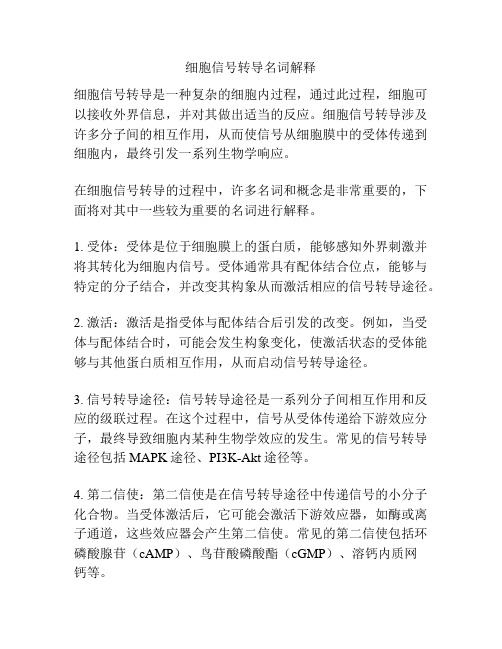
细胞信号转导名词解释细胞信号转导是一种复杂的细胞内过程,通过此过程,细胞可以接收外界信息,并对其做出适当的反应。
细胞信号转导涉及许多分子间的相互作用,从而使信号从细胞膜中的受体传递到细胞内,最终引发一系列生物学响应。
在细胞信号转导的过程中,许多名词和概念是非常重要的,下面将对其中一些较为重要的名词进行解释。
1. 受体:受体是位于细胞膜上的蛋白质,能够感知外界刺激并将其转化为细胞内信号。
受体通常具有配体结合位点,能够与特定的分子结合,并改变其构象从而激活相应的信号转导途径。
2. 激活:激活是指受体与配体结合后引发的改变。
例如,当受体与配体结合时,可能会发生构象变化,使激活状态的受体能够与其他蛋白质相互作用,从而启动信号转导途径。
3. 信号转导途径:信号转导途径是一系列分子间相互作用和反应的级联过程。
在这个过程中,信号从受体传递给下游效应分子,最终导致细胞内某种生物学效应的发生。
常见的信号转导途径包括MAPK途径、PI3K-Akt途径等。
4. 第二信使:第二信使是在信号转导途径中传递信号的小分子化合物。
当受体激活后,它可能会激活下游效应器,如酶或离子通道,这些效应器会产生第二信使。
常见的第二信使包括环磷酸腺苷(cAMP)、鸟苷酸磷酸酯(cGMP)、溶钙内质网钙等。
5. 效应分子:效应分子是信号转导途径中对信号响应的分子。
它们可能是蛋白质、酶或转录因子等。
一次信号转导途径可能涉及多个效应分子,每个效应分子在传递信号时扮演不同的角色。
6. 跨膜受体:跨膜受体是一类能够穿过细胞膜的受体,在信号转导过程中起到关键作用。
跨膜受体分为离子通道受体、酶联受体和G蛋白偶联受体(GPCR)等。
细胞信号转导的研究是细胞生物学领域的重要课题之一。
对细胞信号转导的深入理解有助于揭示细胞功能和生物过程的调控机制,对于疾病的治疗和研发新药也具有重要的指导意义。
简述细胞的信号转导方式

细胞的信号转导是指外界信号通过细胞膜传递到细胞内部,触发一系列生化反应和细胞功能的调控过程。
细胞的信号转导可以通过多种方式进行,其中常见的几种方式包括:
1.直接通透型信号转导:某些小分子信号物质(如气体一氧化氮)、离子(如钙离子)或
水溶性小分子可直接穿过细胞膜,与胞浆内的靶分子发生作用,并触发相应的信号转导反应。
2.膜受体介导的信号转导:大部分信号分子无法直接通过细胞膜,而是通过与细胞膜上特
定的受体结合来传递信号。
这些受体可以是离子通道、酪氨酸激酶、鸟苷酸环化酶等类型的膜受体。
当信号分子与受体结合后,受体会激活下游的信号传递通路,如激活蛋白激酶级联反应或次级信号分子的释放,从而引发细胞内的信号转导。
3.细胞间接触介导的信号转导:有些细胞间信号传递是通过直接接触实现的。
例如,细胞
间的黏附分子可以通过细胞-细胞或细胞-基质之间的物理接触来传递信号。
这种方式通常使细胞与周围环境相互作用,调控细胞的形态、迁移和生长等过程。
4.核内受体介导的信号转导:某些脂溶性信号分子(如类固醇激素和甲状腺激素)可以通
过穿过细胞膜进入细胞,并与细胞核内的核受体结合。
与核受体结合后,信号分子与核受体复合物进入细胞核,影响特定基因的转录和表达,从而调控细胞功能。
这些信号转导方式可以单独存在,也可以相互作用,共同调节细胞的功能和生理过程。
不同的信号转导方式在细胞内部形成了复杂的网络,以确保信号的准确传递和细胞功能的精确调控。
细胞信号转导的特点
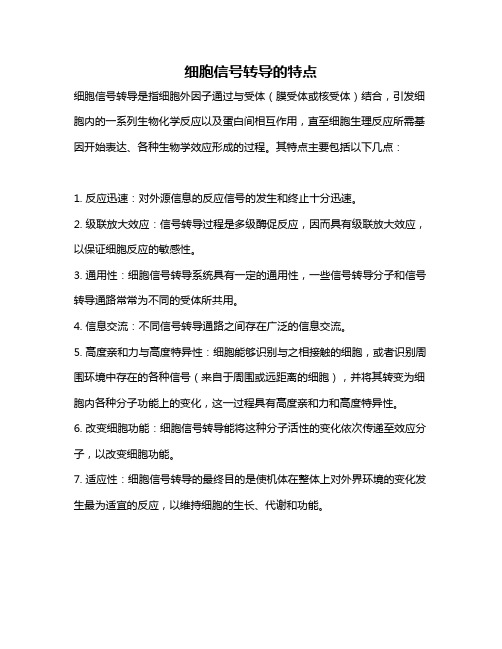
细胞信号转导的特点
细胞信号转导是指细胞外因子通过与受体(膜受体或核受体)结合,引发细胞内的一系列生物化学反应以及蛋白间相互作用,直至细胞生理反应所需基因开始表达、各种生物学效应形成的过程。
其特点主要包括以下几点:
1. 反应迅速:对外源信息的反应信号的发生和终止十分迅速。
2. 级联放大效应:信号转导过程是多级酶促反应,因而具有级联放大效应,以保证细胞反应的敏感性。
3. 通用性:细胞信号转导系统具有一定的通用性,一些信号转导分子和信号转导通路常常为不同的受体所共用。
4. 信息交流:不同信号转导通路之间存在广泛的信息交流。
5. 高度亲和力与高度特异性:细胞能够识别与之相接触的细胞,或者识别周围环境中存在的各种信号(来自于周围或远距离的细胞),并将其转变为细胞内各种分子功能上的变化,这一过程具有高度亲和力和高度特异性。
6. 改变细胞功能:细胞信号转导能将这种分子活性的变化依次传递至效应分子,以改变细胞功能。
7. 适应性:细胞信号转导的最终目的是使机体在整体上对外界环境的变化发生最为适宜的反应,以维持细胞的生长、代谢和功能。
了解这些特点有助于更好地理解细胞如何感知和响应外部刺激,以及如何维持机体的稳态。
如需了解更多相关信息,建议查阅细胞生物学教材或文献。
第12章 细胞信号转导(共63张PPT)
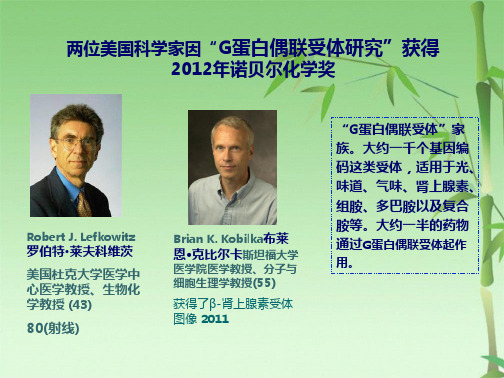
一条肽链糖蛋白 信息传递步骤: 激素与受体结合
受体蛋白的构象改变调节G 蛋白的活性
促进蛋白激酶活性,产生生 物学效应(细胞代谢、基因 转录的调控)
胞质内第二 信使浓度增 加
细胞膜上的酶活
化(AC 等)
❖ G蛋白偶联受体(G-protein coupled receptors, GPCR )作为人类 基因组编码的最大类别膜蛋白超家族,有800多个家族成员,与 人体生理代谢几乎各个方面都密切关联。它们的构象高度灵活, 调控非常复杂,天然丰度很低。
成纤维细胞生长因子(FGF)
血管内皮生长因子(VEGF)
功能:
配体受体结合
受体蛋白质 构象改变
使底物磷酸化,与细胞的增殖、 分化、癌变有关。
(存在自身磷酸化位点,调节酪 氨酸激酶活性)
(二)细胞内受体结构特征
❖ 胞内受体通常为由400~1000个氨基酸组成的单体蛋白,包括四个区域:
❖ ①高度可变区:位于N末端的氨基酸序列高度可变,长度不一,具有转录激活功能。 ❖ ②DNA结合区:其DNA结合区域由66~68个氨基酸残基组成,富含半胱氨酸残基
❖ ③PKA对基因表达的调节作用
表12-2PKA对底物蛋白的磷酸化作用
底物蛋白 核中酸性蛋白质 核糖体蛋白 细胞膜蛋白
微管蛋白 心肌肌原蛋白 心肌肌质网膜蛋白 肾上腺素受体蛋白β
磷酸化的后果
生理意义
加速转录
促进蛋白质合成
加速翻译
促进蛋白质合成
膜蛋白构象及功能改变 构象及功能改变
改变膜对水及离子的通 透性
,具两个锌指结构,由此可与DNA结合。 ❖ ③铰链区:为一短序列,可能有与转录因子相互作用和触发受体向核内移动的
第九章-细胞信号转导(共53张PPT)
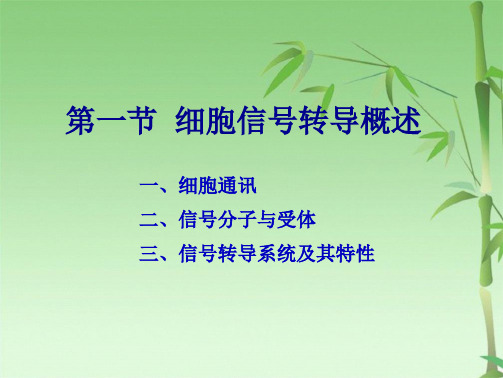
(1)激活靶细胞内具有鸟苷酸环化酶(GC)活性的NO受体。
(2)NO与GC活性中心的Fe2+结合,改变酶的构象,增强酶活性,cGMP水平升高 。
(3)cGMP激活依赖cGMP的蛋白激酶G(PKG),抑制肌动-肌球蛋白 复合物信号通路,导致血管平滑肌舒张。
NO在导致血管平滑肌舒张中的作用
G蛋白偶联受体 的结构图
1234 5
67
G蛋白偶联受体介导无数胞外信号的细胞应答:
包括多种对蛋白或肽类激素、局部介质、神经递质和氨基 酸或脂肪酸衍生物等配体识别与结合的受体,以及哺乳类嗅觉、 味觉受体和视觉的光激活受体(视紫红质)。
哺乳类三聚体G蛋白的主要种类及其效应器
二、G蛋白偶联受体所介导的细胞信号通路
第一节 细胞信号转导概述
一、细胞通讯 二、信号分子与受体 三、信号转导系统及其特性
一、细胞通讯
细胞通讯(cell communication):指信号细胞发出的信息(配 体/信号分子)传递到靶细胞并与其受体相互作用,通过细胞信号
转导引起靶细胞产生特异性生物学效应的过程。
(细胞)信号转导(signal transduction):指细胞将外部信
• IRS1:胰素受体底物
(二)细胞内信号蛋白复合物的装配
• 信号蛋白复合物的生物学意义:细胞内信号蛋白复合物 的形成在时空上增强细胞应答反应的速度、效率和反应的 特异性。
• 细胞内信号蛋白复合物的装配可能有3种不同类型。
细胞内信号蛋白复合物装配的3种类型
• A:基于支架蛋白 B:基于受体活化域 C:基于肌醇磷脂
⑤引发细胞代谢、功能或基因表达的改变;
细胞表面受体(cell-surface receptor): 位于细胞质膜上,主要识别和结合亲水性信号分子,包括分泌型信号分子(如多肽类激素、神经递质
第七章植物细胞的信号转导

1信号转导:受体细胞通过受体接收胞外信号,将胞外信号转变为胞内信号,并经一系列胞内信号转导途径的传导和放大,控制相关基因表达和引起特定的生理生化反应,这种从细胞受体感受胞外信号,到引起特定生理生化反应的一系列信号转换过程和反应机制称为信号转导。
2化学信号:指细胞感受刺激后合成并传递到作用部位引起生理生化反应的化学物质。
3物理信号:指细胞感受到刺激后产生的能够起传递信息作用的电信号和水力学信号等物理性因子。
4第二信使:是指细胞感受胞外环境信号和胞间信号后产生的具有生理调节活性的胞内信号分子,都是小分子物质。
植物中的第二信使主要有cAMP、钙离子、NO、DAG和IP3等。
5受体:存在于细胞表面或细胞内部,能感受信号或与信号分子特异性结合,并引起特定的生理生化反应的生物大分子。
6细胞表面受体:指存在于细胞质膜上的受体,也称膜受体。
通常由与配基相互作用的细胞外结构域、将受体固定在细胞膜上的跨膜结构域和起传递信号作用的胞内结构域3部分组成。
细胞表面受体通常是跨膜蛋白质,大多数信号分子不能过膜,通过与细胞表面受体结合,经跨膜信号转换将胞外信号传至胞内。
7细胞内受体:指存在于细胞质中或亚细胞组分(细胞核、液泡膜等)上的受体。
胞内受体识别和结合的是能够穿过细胞质膜的信号分子。
8配基:指与受体特异结合的化学信号分子。
9钙指纹:指能被细胞识别的、由某种刺激产生的、具有特异性时空变化的钙信息。
10G蛋白:是细胞内一类具有重要生理调节功能的蛋白质,参与细胞信号转导过程的G蛋白主要有小G蛋白和异三聚体G蛋白,其中三聚体G蛋白由β、α、ϒ3个不同亚基构成。
11双信使系统:指肌醇磷脂信号系统。
胞外信号被膜受体接受后以G蛋白为中介,由质膜中的磷脂酶C水解肌醇磷脂,产生两个胞内信号分子:三磷酸肌醇(IP3)和二脂酰甘油(DAG),分别激活两个信号传递途径:IP3-Ca2+和DAG-PKC途径,因此把这一信号系统称为双信号系统。
12激发子:指由病原体产生,并能够激发或诱导植物寄主产生防御反应的因子。
- 1、下载文档前请自行甄别文档内容的完整性,平台不提供额外的编辑、内容补充、找答案等附加服务。
- 2、"仅部分预览"的文档,不可在线预览部分如存在完整性等问题,可反馈申请退款(可完整预览的文档不适用该条件!)。
- 3、如文档侵犯您的权益,请联系客服反馈,我们会尽快为您处理(人工客服工作时间:9:00-18:30)。
1
Outline
• From extracellular signal to cellular response • Cell surface receptors and signal transduction proteins • G-protein coupled receptors (GPCRs): structure and mechanism • GPCRs that regulate ion channels • GPCRs that activate or inhibit adenylyl cyclase • GPCRs that trigger elevation in cytosolic Ca2+
30
6. Study the receptors and activity of signal transduction proteins
1) Purification of receptors
• • Recombinant DNA Affinity chromatography
2) Study the activity of signal transduction protein
<108 mol/L
high affinity
19
1) Eight classes of cell-surface receptors
Signaling via Enzyme -Linked Cell -Surface Receptor
20
Molecular Cell Biology,6th ed., H. Lodish, 2007
cellular responses
• This chain of intermediates: a signal transduction pathway.
3
1. Signaling molecules
1) Intercellular & intracellular signaling molecules
4
2) Signaling molecules act locally or at a distance
5
3) NO and CO
The Nobel Prize in Physiology or Medicine 1998
"for their discoveries concerning nitric oxide as a signalling molecule in the cardiovascular system"
Robert F. Furchgott 1/3 of the prize USA 1916 ~
Louis J. Ignarro 1/3 of the prize USA 1941~
Ferid Murad 1/3 of the prize USA 1936~
6
• Robert F. Furchgott’s work EDRF (endothelium-derived relaxing factor)
25
2) Types of protein kinases and phosphatases
• About 600 protein kinases and 100 phosphatases • Two types of protein kinases: add phosphate to the hydroxyl group on tyrosine residues add phosphate to the hydroxyl group on sersine/threonine residues • The receptor possesses intrinsic kinase activity or tightly bound to a kinase.
•
28
Four common intracellular second messengers
29
2) Advantages of second messengers
• Diffuse through the cytosol much faster than proteins • Facilitate amplification of extracellular signal
Pathways involving proteolysis
Molecular Cell Biology,6th ed., H. Lodish, 2007
21
2) Signaling molecules binding to intracellular receptors
22
3) TheΒιβλιοθήκη steroid receptor superfamily
• • Immunoprecipitation of kinases Pull down assays of GTP-binding proteins
31
Activation of three signal transduction proteins by phosphorylation
32
A pull-down assay shows that the small GTPbinding protein Rac1 is
16
6) Maximal cellular response usually does not require activation of all receptors
17
7) Sensitivity of a cell to external signals
1) The fewer receptors present on a cell, the less sensitive the cell is to the ligand. 2) Hypersensitivity (such as HER2)
11
3) Measure the affinity of a receptor for its ligand a) Dissociation constant
• • Kd=[R][L]/[RL] Kd=[L] which half of the receptors have a ligand bound when the system at equilibrium
12
b) Binding assays to determine the Kd
• For receptors have high affinity for their ligand
13
• For low-affinity ligands
Low-affinity
Low-affinity
High-affinity
3) Desensitization
regulation at the levels of transcription, translation and posttranslational processing, controlling the rate of degradation.
18
3. Cell-surface receptors & intracellular receptors
1) High affinity:
Receptor binds only a single signaling molecule or a group of structurally very closely related molecules.
2) High specificity:
The ability of receptors bind or not bind closely related substances.
48 nuclear receptors
(human), 2 categories: classical endocrine hormones receptors and orphan receptors.
23
24
4. Protein kinases and phosphatases
1) Phosphorylation and dephosphorylation: common cellular mechanism for regulating protein activity
26
A simple signal transduction pathway involving one kinase and one target protein
27
5. Intracellular second messengers
1) Second messengers
• The binding of ligands (first messengers) to many cellsurface receptors leads to a short-lived increase (or decrease) in the concentration of certain low-molecular-weight intracellular signaling molecules termed second messengers. Such as Ca2+ , cAMP, cGMP, DAG, IP3
Signal Transduction and G Protein Coupled Receptors
Han Yingying Dept. of Biochemistry and Molecular Biology
Tel:69156428 E-mail:151259808@ Sep.19 2014
14
4) Molecular complementary
8/28
15
